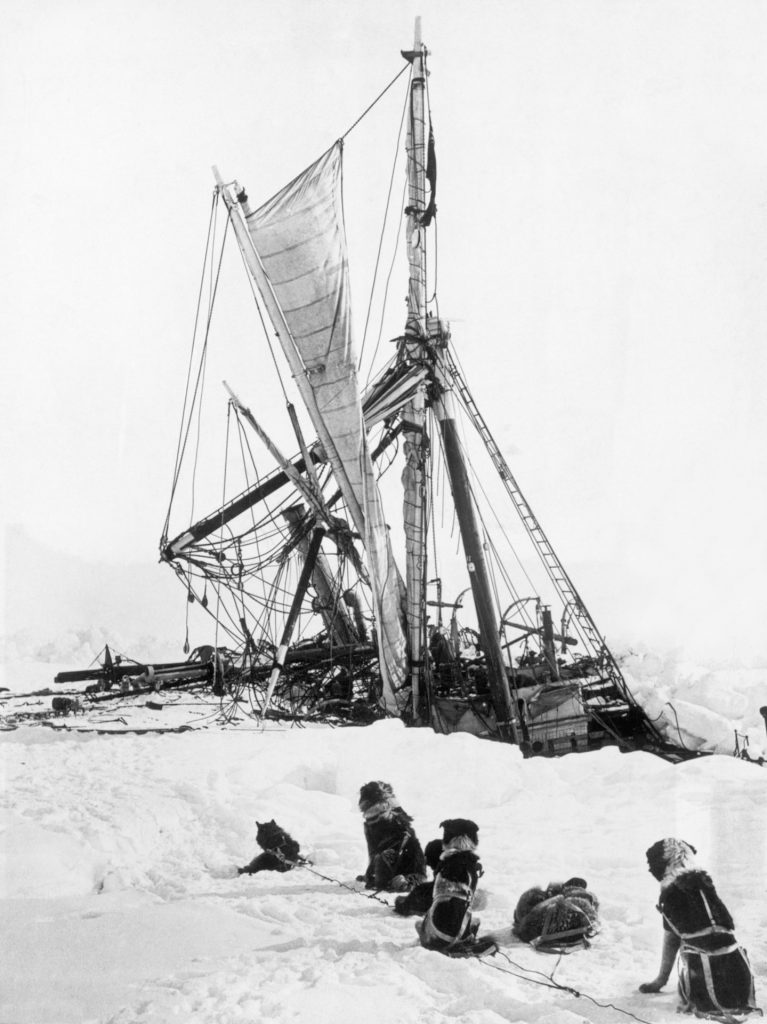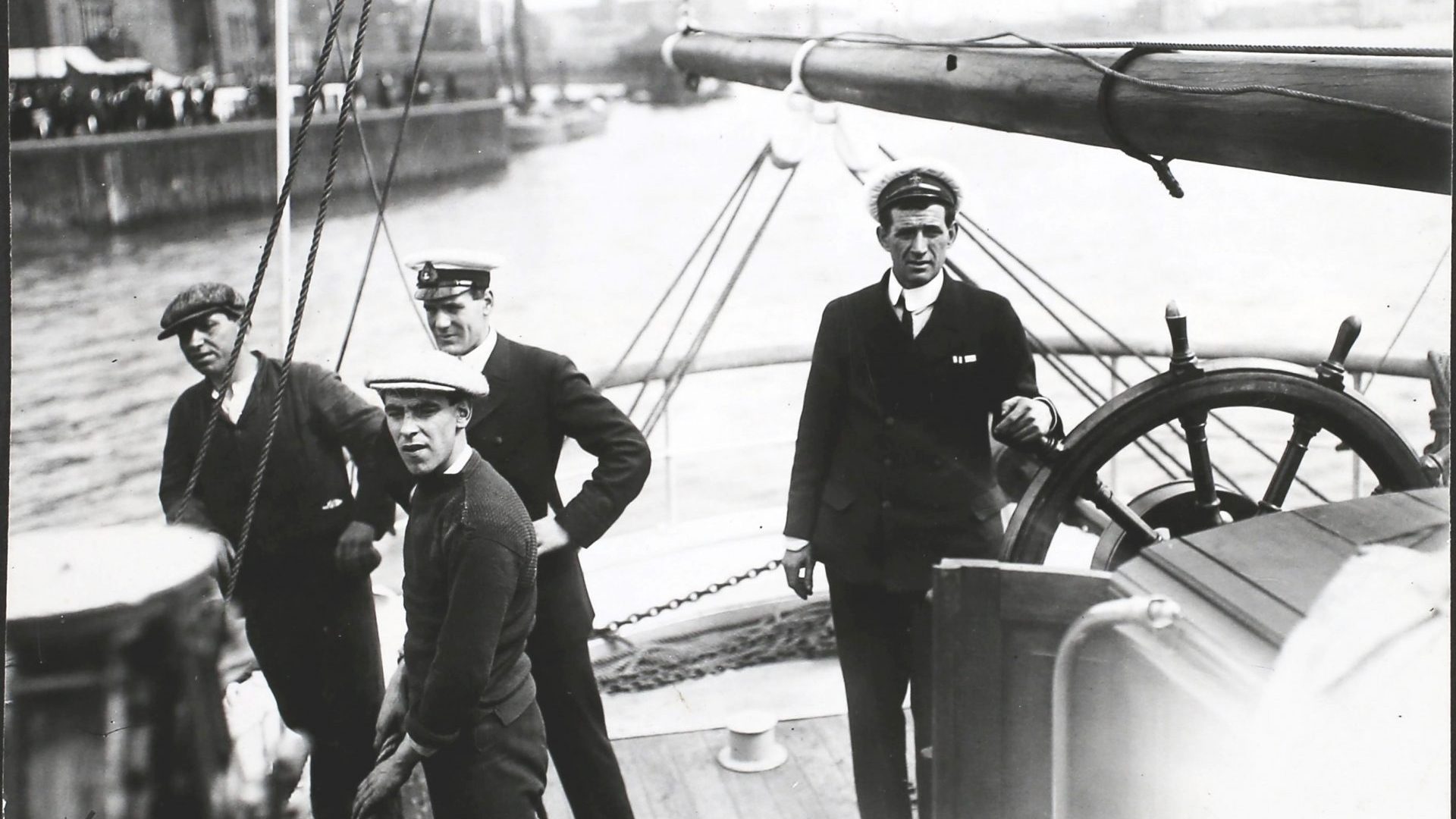When news broke in March that polar explorer Sir Ernest Shackleton’s ship Endurance had been found 3,000 metres beneath the Weddell Sea in Antarctica, the Crean family’s WhatsApp group in southern Ireland went into overdrive, with relatives pinging the stunning underwater footage back and forth.
Tom Crean sailed on the Endurance alongside Shackleton and became Ireland’s most famous polar explorer, even if his exploits were for years shrouded in silence. He also took part in the 1901-1904 Discovery expedition with Captain Robert Scott and the 1910-1913 Terra Nova mission that cost Scott his life, before embarking on the 1914-1917 Imperial Trans-Antarctic Expedition on board the Endurance.
Shackleton, who was himself born in County Kildare in Ireland, planned to walk 1,800 miles across the Antarctic from coast to coast but his vision was thwarted when the Endurance got stuck in the ice and sank in 1915.
Eerie and evocative, the underwater images of the ship show it is almost intact, the name clearly visible on the stern, the wheel frozen for eternity on the empty deck. “It would make the hairs stand up on the back of your neck,” says Tom’s granddaughter Aileen Crean O’Brien, speaking over Zoom from Kenmare, County Kerry, where she runs the Tom Crean brewery and restaurant with her husband, Bill Sheppard. “It’s in such good condition and sitting so proud.”
In the footage filmed by remotely operated submersibles, you can even see boots and crockery inside the vessel. As the ice slowly squeezed the life out of the ship, Shackleton ordered his men to leave nearly all their personal belongings behind, leading the way by dramatically flinging his gold watch, cigarette case and a few gold sovereigns into the snow.
If the story of the Endurance is the ultimate tale of hard men in a hard place, then Tom Crean may have been the hardest man of all. But for years, his seminal role in Britain’s Heroic Age of Antarctic Exploration was essentially unknown to the wider public.
One of 10 children born to a poor family in the village of Annascaul on Kerry’s Dingle Peninsula, Crean left school at 14 and, in 1893, ran away to join the Royal Navy aged just 15 after a row with his father over cows straying into a potato field.
It wasn’t an entirely original escape route: there was a history of men from the village joining the navy and then coming back with pensions and setting up businesses. Crean may well have heard some of these stories at local markets. From the family home, perched on a hill in Gurtachrane, Crean could also see Minard Castle, where men could sign up to the navy.
“He recognised he was in a family situation that did not have much future and he did something about it,” says Aileen, 61. “That took courage and determination initially and then to stick out the tough naval training and the rough-and-tough life, starting at the bottom of the ladder and working his way up. He never gave up,” she says.
So began an adventure on the high seas that saw the young man take a critical role in three of the four best-known Antarctic expeditions, alongside legendary explorers Scott and Shackleton. Unlike his heroes, though, Crean survived his forays into the world’s most hostile environment, even if he never really told the tale. Or not in so many words.
The Endurance expedition made a legend of Shackleton, even though his original plan never really got off the ground: the 144-foot ship quickly got stuck in the ice and eventually it sank, leaving Shackleton and his 27-strong crew seeking refuge on drifting pack ice. Eventually, they set out on a perilous journey in three flimsy lifeboats to find refuge. They ended up on Elephant Island, where at least there was some rudimentary shelter and food.
But they couldn’t stay there for ever and with no chance of a passing ship coming to the rescue, Shackleton and five other men, including Crean and Timothy McCarthy from Cork, set off in the 22.5-foot James Caird to cross around 800 miles of the Southern Ocean and raise the alarm at the Stromness whaling station on South Georgia Island. Miraculously, and thanks to the superb navigational skills of Endurance captain Frank Worsley, they made it to South Georgia, where Shackleton, Crean and Worsley had to cross the uncharted land on foot – an incredibly daring 36-hour trek to complete a mammoth journey that has been feted down the ages as one of the greatest rescue stories of modern history.
Even though it failed spectacularly, the Imperial Trans-Antarctic Expedition secured Shackleton’s celebrity. Geologist Raymond Priestley quipped: “When disaster strikes and all hope is gone, get down on your knees and pray for Shackleton.” In fact, in tight situations, Shackleton was probably praying for Crean.
In his 2000 book, An Unsung Hero: Tom Crean, Antarctic Survivor, Michael Smith paints a picture of a formidable character; Crean was brave, imperturbable, capable, cheerful and strong. The kind of man you’d want in a tight corner.
Crean’s role on the various expeditions he took part in was so key that Smith even speculates on whether he could have changed the course of history on Scott’s fateful last expedition. Scott did not choose Crean for the final dash to the South Pole, instead sending him back to base camp with Lieutenant Edward “Teddy” Evans and William Lashly, and choosing to go forward with four other men instead.
Smith argues that Scott made a fundamental error in not taking Crean because the Kerryman might have made a vital difference on the return journey. In fact, Crean did save a life as he trekked back to base camp but it was Evans’. He was suffering from scurvy and getting weaker and weaker as the days passed.
Eventually, Lashly and Crean had to haul Evans behind them until finally, Evans could travel no further and Crean set off on a solo 35-mile trek to fetch help, sustained only by three biscuits and two sticks of chocolate. It took 18 hours but he made it to the camp at Hut Point and was able to organise a rescue for Evans and Lashly, who had stayed behind to take care of the sick man. Crean and Lashly were awarded the Albert medal for their bravery.
Evans – who described Crean as a “raw-boned Irishman with the most comically serious face” – remained forever grateful. As did his parents, who sent two signed photos to Crean in gratitude – photos that were still in Aileen’s sitting room as she grew up.
Aileen says her grandfather was a great team player, very caring but also tough. “Nothing seemed to intimidate him, he appeared to be fearless yet I think he calculated the risks. Despite all his achievements, he remained grounded. This giant of a man, so strong physically and mentally and yet he wasn’t afraid to express his emotions.
Despite his front-row seat to the golden age of Antarctic exploration, Crean’s incredible exploits were largely unknown for decades. He retired from the navy in 1920 and returned home. But the Ireland Crean came back to was, in the words of WB Yeats’ Easter, 1916 poem, “changed, changed utterly” by the uprising that same year.
Soon Crean’s family was caught up in the subsequent war for independence: his brother Cornelius, who was a sergeant in the Royal Irish Constabulary, was shot dead by the Irish Republican Army in 1920, just a month after Tom returned home from the navy.
Then, his wife Nell, whom he married in 1917, went to a rally to commemorate Thomas Ashe, one of the leaders of the Easter Rising who was from the nearby townland of Kinard and who died while on hunger strike in jail in 1917. After the rally, the Black and Tans – irregular forces used to bolster British army forces in Ireland during the war – came to the Crean family home and held Tom at gunpoint. Nell, who was heavily pregnant with her daughter Katie at the time, always blamed the trauma for the fact that her daughter was born sickly. Katie had epilepsy and died in 1924.
After all of this, Crean put away his medals and his ceremonial dress sword and rarely spoke of his role in three of Britain’s most significant polar expeditions.
“It was the political climate but it was also as if he’d closed a chapter in his life. He didn’t talk about it, he didn’t give interviews,” said Aileen.
Instead, Tom and Nell devoted themselves to running their pub, the South Pole Inn, in Annascaul. Crean, who bought the pub years before, contented himself with sitting quietly on the village bridge, watching the world go by, or walking his beloved dogs along the beaches. He also regularly walked to the local railway station to pick up the English papers. He especially liked the Daily Mail because it listed naval appointments and retirements.

In Honouring Tom Crean, the book she wrote with Bill, Aileen tells how Tom was nicknamed ‘Funny’ by the Knightly family who lived in the railway house where he collected his newspapers.
She tells me that Tom used to go walking with children from the village and when he returned home, he would always bathe his battered feet, still marked by the ravages of frostbite. The children always desperately wanted to see his feet – they thought there would be actual bite marks on his toes – but usually Nell would chase them away. One day they got in and found that his toes were intact and it was a huge disappointment. “He was no longer their hero,” Aileen laughs.
Crean died of complications from appendicitis in 1938, and for decades his story was buried in the mists of time. Even his family didn’t know the full details of his exploits, although Aileen recalls that she always knew her grandfather was special.
“Growing up we just had a three-bed, semi-detached house and the sitting room was only used at Christmas and it held all his stuff. His dress sword was on the breast of the fireplace, there was a silver tea set, which was a wedding gift from Shackleton, and there were autographed photographs of Evans’ mother and father and a letter in gratitude for Tom being instrumental in saving their son’s life,” she says. “I suppose I was intrigued by this fella. Why would you go to such a cold place three times? How would you get from Annascaul to Antarctica? He definitely wasn’t a run-of-the-mill grandfather.”
Today, Crean’s story is taught in Irish primary schools and a scientific research vessel bearing his name is due to be launched in Galway this year. His memory lives on in Antarctica as well, where visitors can gaze upon Mount Crean in South Victoria Land or perhaps traverse Crean Glacier, as Aileen set out to do with her two sons and Bill in 2016, the centenary of the original journey by her grandfather.
“It was to get a sense of what he experienced because I was fascinated. Why would you go to such a cold place, not just once but three times? Why would you keep going back?” she said.
The four all trained fiercely before the trip, with Aileen and her sons dragging tyres along the roads near Kenmare and Bill learning to ski in Poland.
When they finally arrived in South Georgia, it was worth all the effort. “It was just amazing, like someone dropped Switzerland into the sea. Snow-capped mountains and the sun was shining, and it was just beautiful. As we came into Cumberland Bay, there was pancake ice (and) all you could hear was the crackle of the ice breaking as we gently came in. The silence was deafening except for the sound of the elephant seal pups,” Aileen said.
During the expedition, Aileen tried to recreate a particularly daring part of her grandfather’s incredible overland journey: at one point, the three men fashioned a toboggan out of a 50-foot rope to glide down a steep slope to avoid a much longer trek.
Crean, Shackleton and Worsley sat on the sled, legs around waists, arms around necks, and pushed off. Somehow they survived the descent, and then hauled themselves to their feet and solemnly shook hands. Unfortunately, Aileen did not have such a soft landing. She broke her leg and that was the end of the trip as she had to be man-hauled over the ice for two days and eventually sailed back to Grytviken.
“To break my leg on Crean glacier of all the glaciers,” she says ruefully. “(Tom) was probably saying, ‘why didn’t you stay at home, you big eejit’.”
The experience made her acutely aware of the dangers faced by her grandfather and the other polar explorers. And even though our world is so different from theirs, just as the Endurance has survived intact miles below the surface of the freezing Weddell Sea, so the stark and heartless beauty of the Antarctic remains the same. At least for now.
“It’s still a fierce place. You’re still dealing with the same elements as back then,” says Aileen. “There are no points of reference. It’s white and sky, and white and sky, and it all looks the same.”
To learn more about Tom Crean, you can visit the Tom Crean exhibition at the Kerry County Museum in Tralee.











